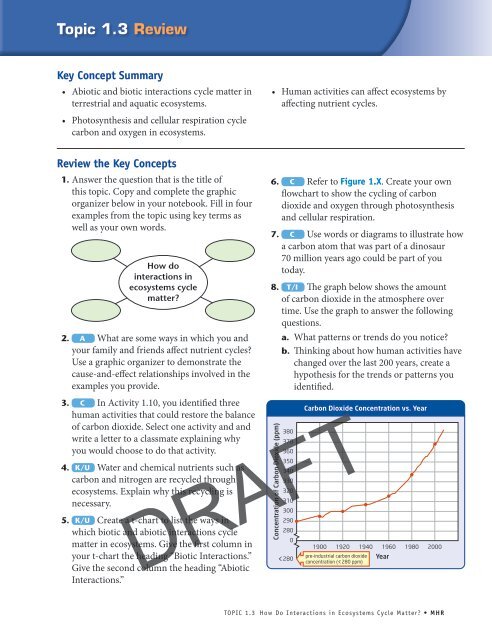Sustainable Ecosystems and Human Activity
Sustainable Ecosystems and Human Activity
Sustainable Ecosystems and Human Activity
- No tags were found...
Create successful ePaper yourself
Turn your PDF publications into a flip-book with our unique Google optimized e-Paper software.
Topic 1.3 ReviewKey Concept Summary• Abiotic <strong>and</strong> biotic interactions cycle matter interrestrial <strong>and</strong> aquatic ecosystems.• Photosynthesis <strong>and</strong> cellular respiration cyclecarbon <strong>and</strong> oxygen in ecosystems.• <strong>Human</strong> activities can affect ecosystems byaffecting nutrient cycles.Review the Key Concepts1. Answer the question that is the title ofthis topic. Copy <strong>and</strong> complete the graphicorganizer below in your notebook. Fill in fourexamples from the topic using key terms aswell as your own words.How dointeractions inecosystems cyclematter?2. A What are some ways in which you <strong>and</strong>your family <strong>and</strong> friends affect nutrient cycles?Use a graphic organizer to demonstrate thecause-<strong>and</strong>-effect relationships involved in theexamples you provide.3. C In <strong>Activity</strong> 1.10, you identified threehuman activities that could restore the balanceof carbon dioxide. Select one activity <strong>and</strong> <strong>and</strong>write a letter to a classmate explaining whyyou would choose to do that activity.4. K/U Water <strong>and</strong> chemical nutrients such ascarbon <strong>and</strong> nitrogen are recycled throughecosystems. Explain why this recycling isnecessary.5. K/U Create a t-chart to list the ways inwhich biotic <strong>and</strong> abiotic interactions cyclematter in ecosystems. Give the first column inyour t-chart the heading “Biotic Interactions.”Give the second column the heading “AbioticInteractions.”6. C Refer to Figure 1.X. Create your ownflowchart to show the cycling of carbondioxide <strong>and</strong> oxygen through photosynthesis<strong>and</strong> cellular respiration.7. C Use words or diagrams to illustrate howa carbon atom that was part of a dinosaur70 million years ago could be part of youtoday.8. T/I The graph below shows the amountof carbon dioxide in the atmosphere overtime. Use the graph to answer the followingquestions.a. What patterns or trends do you notice?b. Thinking about how human activities havechanged over the last 200 years, create ahypothesis for the trends or patterns youidentified.Concentration of Carbon Dioxide (ppm)Carbon Dioxide Concentration vs. Year38037036035034033032031030029028001900 1920 1940 1960 1980 2000pre-industrial carbon dioxide Year
















